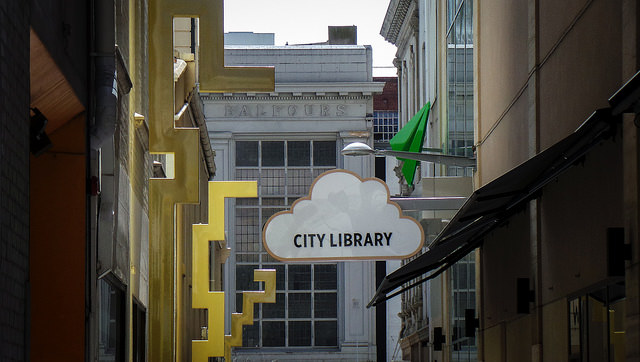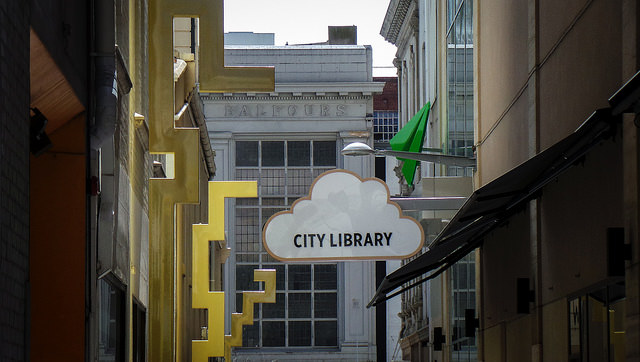
To build better libraries, start with the needs of people
Knight News Challenge: Libraries offers applicants a chance to share in $2.5 million by focusing on the question “How might we leverage libraries as a platform to build more knowledgeable communities?” Below, Emi Kolawole, the editor-in-residence at the Standford d.school, writes about putting the needs of people first in libraries. Photo by Emi Kolawole.
When was the last time you set foot in a library? Were you looking for a book, a quiet place to study, or were you hunting down a free Wi-Fi connection? Perhaps you don’t even remember.
The last library I walked into was the library here at the Stanford d.school. Like just about everything at the d.school, this isn’t your standard library. There are rainbow-colored blocks, board games and paper cranes. Workspaces exist at multiple levels. There are tall desks, couches and lounge chairs. There are whiteboards and, yes, even some books.

RELATED LINKS
“Powerful ideas push the boundaries of what libraries can be” by Stephanie Pereira (09/24/14)
“Make the most of your submission for Knight News Challenge: Libraries” by Chris Barr and John Bracken (09/23/14)
“Lesa Mitchell, Network for Scale: A new opportunity for libraries” on Knight blog (9/19/14)
“Lessons in sharing, from the public library” by Nate Hill on Knight blog (9/18/14)
“Bianca St. Louis, CODE2040: ‘I envision libraries as a creative space and entrepreneurial hub’” on Knight blog (9/18/14)
“Why Libraries?” by Sheila Murphy on Knight blog (9/17/14)
“Libraries cultivate connections, community and more in the digital age” by Anthony Marx on Knight blog (9/15/14)
“Can research libraries adapt to live up to their potential?” by Bernard Reilly on Knight blog (9/12/14) “Finding the sweet spot for libraries in the digital age” by Jill Bourne on Knight Blog (9/11/14)
“Knight News Challenge: Libraries opens for entries” by John Bracken on Knight Blog (9/10/14)
“Why Libraries [Still] Matter” by Jonathan Zittrain on Medium (9/10/14)
“News Challenge to explore role of libraries in the digital age” by John Bracken on Knight Blog (8/25/14)
“Knight News Challenge on Libraries offers $2.5 million for innovative ideas ” – Press Release (8/10/14)
What’s interesting about the space is that when I first encountered it — on my second visit to the d.school — the room was a conference room. Faculty and staff would gather there for meetings — both scheduled and impromptu. In fact, I was interviewed in that space for the position I currently hold. How did it transform into a library? There was one key ingredient: silence.
Nowhere at the d.school is silence insisted upon other than in the library. It is a place for quiet study and reflection — not the vibrant, generative collaboration often seen around the d.school. Members of the d.school team respect the rules (generally), and soft reminders are given to those who momentarily forget.
It took some adjustment. Those accustomed to using the space as a meeting room attempted, at times, to defy the new intentions for the space. But eventually everyone came around.
The design sprang out of an emerging need within the d.school community: Radically creative and collaborative individuals needed a space in which to synthesize ideas that had been shared with them and to generate ideas of their own because creative sparks and inspiration are not restricted to in-person meetings.
In other words, the community needed a place with a different but complementary energy. So far, it’s working. The d.school library is, when you really need to focus, a calming and useful space that allows one to share in and draw inspiration from the quiet energy of others.
So, what does that mean for attempts to redesign a library for a much larger community? It means the same as it does for any design challenge: Start with people.
One of the most impactful stories of observation and empathy I have ever heard — and one I tell everyone — is that of the Chicago Public Library. The staff noticed people were sitting on the library steps after it had closed. Why? People wanted — needed — access to the Internet, and the library was one of few places that offered such access for free. The Chicago Public Library received a Knight News Challenge grant this year to begin distributing Wi-Fi hotspots, allowing people to check them out as they would books. The library will also offer classes on digital skills.
That’s just one potential pivot. What if, instead of merely a quiet space or a place to rent books or Wi-Fi hotspots, the library was a maker space where going meant learning how to use a laser cutter, a CNC machine or a 3-D printer? What if the library was a co-working space or a studio for shooting how-to videos or MOOCs. What if the library was a test kitchen? What if it was a combination of all of the above?
It’s all about what people need — what a community needs.
So, as you explore this challenge, interview people, and as soon as you think you have spoken with enough people, interview one more. Push hard against assumptions and defer judgment. See everything — spaces, people, objects — as if you are seeing them for the first time. Be bold when making your inferences, and stay optimistic. Perhaps the room you’re standing in today — whether it’s a living room, train car, office or warehouse — could be home to the great library of tomorrow.
You can join us for virtual office hours on Monday, Sept. 29, from 2:30 to 3:30 p.m. ET. Participants can access the meeting online (https://bluejeans.com/731675489/browser using ID 731675489), or participate via phone at 1-888-240-2560.
To submit an entry or provide feedback on other submissions, visit newschallenge.org. Knight News Challenge: Libraries closes at 5 p.m. ET on Sept. 30. Winners will be announced in January.
Recent Content
-
Journalismarticle ·
-
Journalismarticle ·
-
Journalismarticle ·


